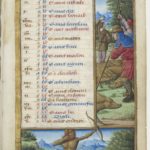Cecilia may or may not have been real, and the stories about her and her companions are certainly fictional, but she has remained securely ensconced on the kalendar since the fourth century.

“November”, kalendar page from Les Petites Heures d’Anne de Bretagne (The Little Hours of Queen Anne of Bretagne), by the Maître des Triomphes de Pétrarque. From Bibliothèque nationale de France, Paris (France).
Ultimately the trio was arrested and sentenced to death by the prefect Turcius Almachius. Cecelia’s Legend says that the swordsman struck her three times on the neck but that she clung to life for three days. At her request, Urban converted her home into a church. She was buried in the Catacomb of Callixtus, and her relics were later transferred to the Church of Santa Cecilia in Trastavere.
Cecilia has had a large impact on the world of music and poetry. “The Second Nun’s Tale” in Chaucer’s Canterbury Tales is a retelling of her Legend, and the first music festival in her honor took place in Évreux in Normandy in 1570. In 1585, the National Academy of Santa Cecilia was founded by Sixtus V’s papal bull, Ratione congruit (which also invoked Gregory the Great, music’s other patron saint, after whom Gregorian chang is named). John Dryden and Alexander Pope both wrote odes in her honour, and composers as varied as Handel, Gounod, Britten, Howells, and Finzi have all written works in her honor.
Cecilia’s feast day is November 22nd.


